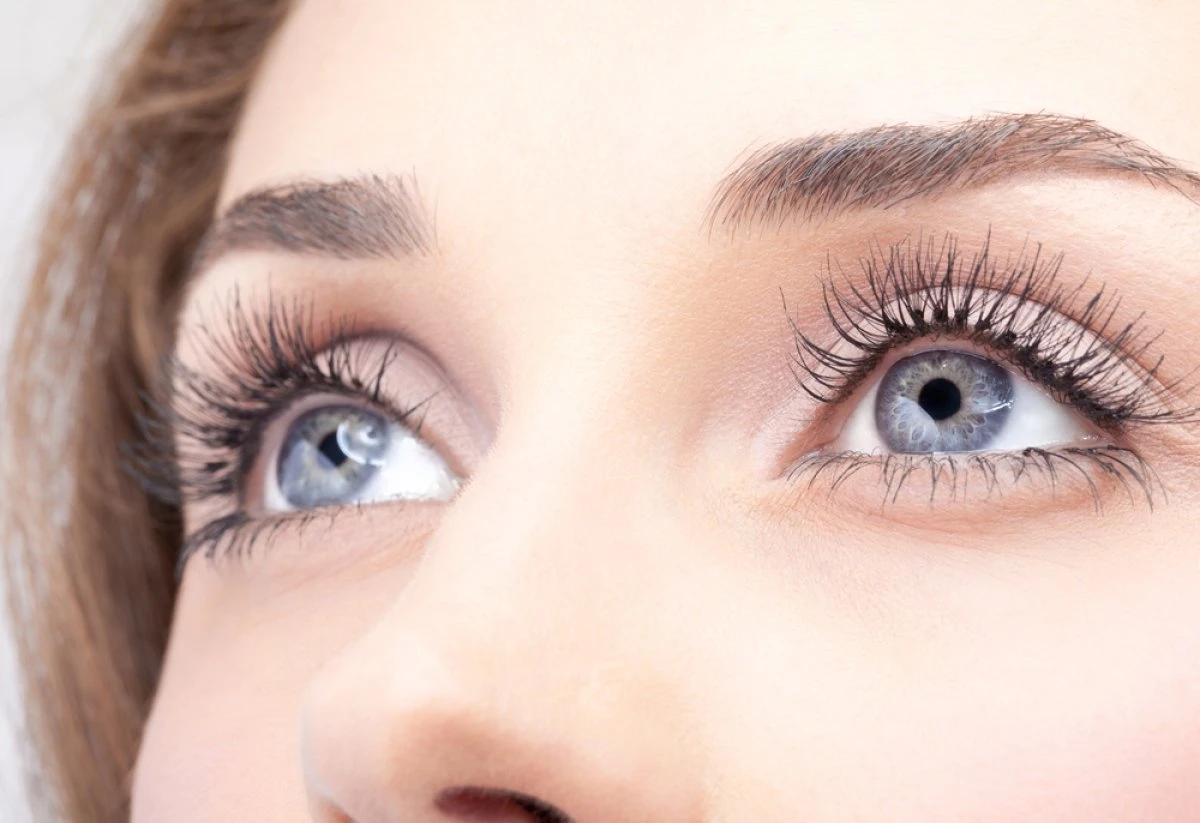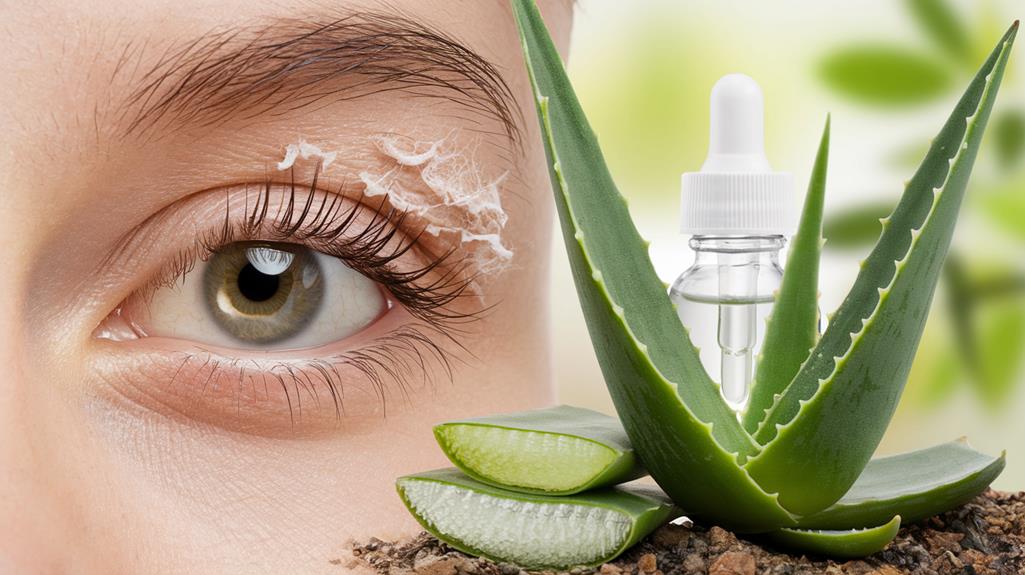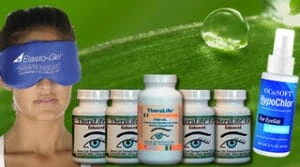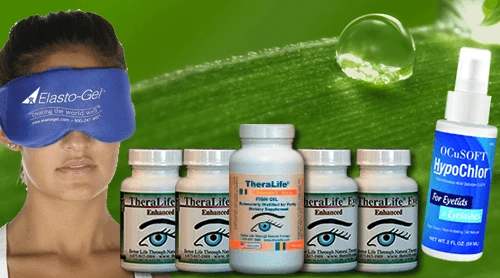Dry eyelids, often caused by environmental factors such as low humidity, prolonged screen time, and dermatitis (contact or atopic), can present as flakiness, redness, and persistent irritation.
To alleviate these symptoms quickly, TheraLife offers specialized products designed to provide fast relief. Their range of products, which include moisturizers enriched with glycerin, shea butter, or dimethicone, are formulated to soothe dry eyelids effectively.
Using warm compresses, as recommended by TheraLife, can also enhance oil gland function and provide immediate comfort.
To improve eyelid hygiene, TheraLife suggests using soap-free, fragrance-free cleansers, which help maintain the sensitive skin around your eyes without causing irritation. Additionally, maintaining ambient humidity with the use of a humidifier can significantly improve symptoms.
TheraLife’s comprehensive approach not only addresses the symptoms but also targets the underlying causes to enhance your comfort and recovery.
For persistent symptoms, significant inflammation, or conditions like blepharitis, TheraLife recommends seeking professional advice to ensure proper treatment.
Understanding the root causes and utilizing TheraLife’s effective treatments can greatly enhance your quality of life.
Key Takeaways
- Environmental Factors: Low humidity and cold weather can cause dry eyelids.
- Effective Treatments: TheraLife’s natural supplements offer a holistic oral approach to managing dry eyes and eyelids, providing relief without the side effects of topical corticosteroids and calcineurin inhibitors.
- Home Care Solutions: TheraLife products, enriched with natural ingredients, are designed to nourish and hydrate dry eyelids, complementing moisturizers containing glycerin, shea butter, or dimethicone.
- Hygiene Practices: Regularly clean eyelids with TheraLife’s gentle, soap-free, fragrance-free cleansers, and use warm compresses to alleviate discomfort.
- When to Seek Help: If symptoms persist or worsen despite using TheraLife’s self-care solutions, consult a doctor for further evaluation and guidance.
Best All Natural Oral Dry Eye Treatment for Dry Eyelids.
Oral treatment from inside out. No more drops.
Add To Cart
Causes of Dry Eyelids
Dry eyelids can arise from a variety of factors, each contributing to the discomfort and irritation experienced. Environmental factors such as low humidity, cold weather, and exposure to pollutants exacerbate skin dryness, particularly affecting the delicate skin of the eyelids. These conditions strip away natural oils, leading to moisture loss and increased skin fragility.
Additionally, prolonged exposure to dry air and prolonged screen time can worsen symptoms, causing discomfort around the eye area.
Contact dermatitis is another common cause, triggered by reactions to cosmetics, soaps, or environmental irritants. This condition results in redness, itchy skin, and flakiness. The allergens or irritants in these products disrupt the skin barrier, leading to inflammation and dryness.
Atopic dermatitis, or eczema, also contributes considerably to dry eyelids. This chronic skin condition often presents with a history of allergies or asthma and manifests as persistent dryness and irritation. Eczema affects the eyelid skin’s ability to retain moisture, exacerbating dryness.
Aging naturally reduces the number of oil and sweat glands in the skin, diminishing its capacity to retain moisture and making it more susceptible to dryness.
Conditions like blepharitis, which involve inflammation of the eyelid margins, further complicate matters by causing redness, crusting, and dryness. Maintaining proper eyelid hygiene is essential in managing these symptoms and preventing further irritation.
Symptoms to Watch For
Several key symptoms can indicate the onset of dry eyelids, necessitating close observation. Common symptoms of dry eyelids include flakiness, rough texture, and scaling, which often cause discomfort and irritation, particularly during blinking.
You may notice redness and swelling around the eyelids, which could signal an underlying dermatological condition such as dermatitis or blepharitis.
Persistent itching and burning sensations are also prevalent and may indicate allergic reactions or irritant contact dermatitis. These symptoms can be particularly distressing and may interfere with daily activities.
Additionally, crustiness or oozing on the eyelids is often associated with blepharitis, leading to further irritation and the need for meticulous hygiene.
In some cases, dry eyelids can trigger increased tearing as your body attempts to counteract the lack of moisture in the eye area. This paradoxical response can add to the overall discomfort, making it essential to address the underlying causes promptly.
Being vigilant about these symptoms will help you identify dry eyelids early, allowing for timely and effective management. Recognizing these clinical signs is vital for preventing complications and ensuring ideal ocular health.
Effective Treatments
To effectively manage dry eyelids, you can utilize both prescription medication options and home care solutions.
Topical corticosteroids are often prescribed for severe inflammation, while over-the-counter moisturizers with ingredients like glycerin and dimethicone can hydrate and improve skin texture.
Additionally, regular eyelid hygiene and warm compresses can alleviate symptoms and support better oil gland function.
For more thorough relief, consider the benefits of an oral formulation like TheraLife Eye Enhanced, which targets the root causes of dry eye by enhancing micro-circulation and natural tear production.
Prescription Medication Options
Managing dry eyelids effectively often involves prescription medications tailored to the underlying causes, providing targeted relief and symptom control. For dermatitis conditions like atopic dermatitis, healthcare providers may prescribe topical corticosteroids. These medications reduce inflammation and itching, offering considerable relief. Alternatively, topical calcineurin inhibitors such as tacrolimus and pimecrolimus are used for moderate-to-severe atopic dermatitis, as they avoid the side effects typically associated with steroids.
If you’re dealing with blepharitis, antibiotic ointments or drops can be effective. These treatments help eliminate bacterial overgrowth and reduce inflammation around the eyelids. For severe eczema affecting the eyelids, systemic medications like oral corticosteroids or immunosuppressants may be necessary. These options are generally considered when topical treatments aren’t sufficient.
It’s important to maintain regular follow-ups with your dermatologist or healthcare provider. Continuous monitoring allows for adjustments to your treatment plan, ensuring maximum effectiveness and minimizing potential side effects.
| Condition | Medication Type |
|---|---|
| Atopic Dermatitis | Topical Corticosteroids |
| Atopic Dermatitis | Topical Calcineurin Inhibitors |
| Blepharitis | Antibiotic Ointments/Drops |
| Severe Eczema | Systemic Medications |
Understanding your options and collaborating with healthcare providers can make a significant difference in managing dry eyelids.
Home Care Solutions
Effectively managing dry eyelids at home involves a combination of strategic hydration and gentle care. Start by integrating over-the-counter moisturizers that contain glycerin, shea butter, or dimethicone into your daily routine. These ingredients are clinically proven to effectively hydrate dry eyelids when applied several times a day, promoting moisture retention.
If you suffer from chronic dry eyes, consider exploring natural alternatives that target the root cause of dryness. Complement your moisturizing regimen by using a humidifier in your living spaces. This device helps maintain ideal moisture levels in the air, which is particularly beneficial in cold or dry climates, effectively reducing eyelid dryness.
Gentle cleansing is vital. Opt for soap-free, fragrance-free products to avoid further irritation and support the healing process. Regularly applying warm compresses to your eyelids can also provide significant relief. This practice soothes irritation, enhances oil gland function, and aids in moisture retention.
Maintaining a consistent eyelid hygiene routine is essential. This includes regular washing and using hypoallergenic products designed specifically for sensitive skin. Such a routine not only manages current symptoms but also prevents future episodes of dry eyelids.
Home Remedies
Several effective home remedies can alleviate dry eyelids, providing much-needed relief and hydration. Here are three methods you can implement to soothe your eyelid discomfort:
1. Moisturizers: Applying over-the-counter moisturizers containing glycerin, shea butter, or dimethicone several times a day can effectively hydrate and soothe dry eyelids.
These ingredients are designed to lock in moisture and form a protective barrier on the skin, alleviating irritation and dryness. For those with chronic dry eyes, addressing the root cause of underactive tear production can also be beneficial.
2. Warm Compresses: Using warm compresses for 5-10 minutes can greatly improve the function of your eyelid oil glands, providing relief from dryness and discomfort.
This practice helps to melt any hardened oils in the gland ducts, promoting better lubrication of the eyelid margin.
3. Humidifier and Gentle Cleansing: Incorporating a humidifier into your living space boosts moisture levels in the air, reducing skin dryness.
Additionally, practicing eyelid hygiene with soap-free, fragrance-free cleansers can prevent further irritation. Gently cleaning the eyelid margin with a warm washcloth helps remove debris and reduces inflammation, particularly in conditions like blepharitis.
Avoiding hot water during face washing further helps retain skin moisture.
Preventive Measures
To effectively prevent dry eyelids, it’s essential to establish a regular moisturization routine using hypoallergenic products that maintain skin hydration.
Additionally, avoid known irritants like harsh soaps, cosmetics, and allergens, as these can exacerbate dryness and lead to dermatitis.
Using a cool-mist humidifier can also help to maintain moisture in the air, preventing the skin around your eyes from drying out.
Implementing these measures can greatly reduce the incidence of dry eyelid symptoms.
Avoiding Known Irritants
When it comes to preventing dry eyelids, identifying and steering clear of known irritants is essential. Numerous factors can contribute to this condition, ranging from skincare products to environmental triggers. For instance, contaminated eye makeup can lead to blepharitis and conjunctivitis, worsening symptoms with continued use.
To protect your delicate eyelid skin, consider the following preventive measures:
- Use Hypoallergenic Products: Opt for hypoallergenic skincare and makeup products to minimize allergic reactions that can lead to dryness and irritation. Fragrances and certain chemicals in these products can be common irritants.
- Avoid Touching Your Face: Regularly washing your hands and consciously avoiding touching your face can greatly reduce the transfer of irritants and allergens to your eyelids. This simple practice helps maintain skin hydration and prevents exacerbation of dry eyelids.
- Limit Exposure to Environmental Triggers: Environmental factors, such as smoke, pollution, and extreme weather conditions, can strip moisture from your skin. Limiting your exposure to these elements will help maintain ideal skin hydration and reduce the risk of developing dry eyelids.
Additionally, keeping a detailed diary of the products you use and your daily activities can help you identify specific triggers.
Regular Moisturization Routine
After identifying and avoiding known irritants, establishing a regular moisturization routine is key to preventing dry eyelids. Integrating hypoallergenic creams or ointments specifically formulated for sensitive eyelid skin into your daily regimen can greatly mitigate dryness and irritation.
Look for moisturizers that contain glycerin, shea butter, or dimethicone. These ingredients are renowned for their ability to lock in moisture and create a robust protective barrier on the skin. Additionally, using a hot compress can provide immediate relief from dry and irritated eyes by enhancing gland function and improving eye comfort.
Apply your chosen moisturizer at least twice daily, particularly after cleansing. This practice helps maintain ideal hydration levels and shields your skin from environmental factors that exacerbate dry eyelids.
Additionally, employing a humidifier in your living space can enhance air moisture, particularly during dry seasons or in arid climates, providing further support for skin hydration.
Incorporating gentle eyelid hygiene practices is also essential. Use warm compresses and gentle cleansers to enhance the effectiveness of your moisturizing routine and minimize potential irritation.
When to Seek Help
When to Seek Help
If your dry eyelids don’t improve with self-care measures, it’s vital to seek medical attention, as persistent symptoms might indicate an underlying condition requiring professional treatment.
Persistent symptoms such as irritation, swelling, severe redness, or pain can signal an allergic reaction or infection. Additionally, if you notice oozing, crustiness, or significant irritation around the eyelids, obtaining a professional evaluation is important.
Conditions like blepharitis can cause painful swelling and require medical management.
When you seek medical attention, a healthcare provider can help identify specific allergens or irritants contributing to your symptoms. They can provide tailored management strategies, ensuring you receive the appropriate professional treatment.
Timely consultation is vital, especially if you experience sudden changes in your eyelid condition, as early diagnosis can prevent complications and lead to more effective treatment.
Here are three key signs you should consult a doctor for your dry eyelids:
- Persistent Symptoms: Swelling, severe redness, or pain that doesn’t resolve with self-care measures.
- Additional Symptoms: Oozing, crustiness, or significant irritation around the eyelids.
- Sudden Changes: Any abrupt alterations in your eyelid condition, indicating a need for early diagnosis and intervention.
Frequently Asked Questions
What Can I Do for Extremely Dry Eyelids?
For extremely dry eyelids, TheraLife offers a range of products and solutions designed to provide relief and promote eye health.
TheraLife’s products, such as their Eye Enhanced supplement, are formulated to address underlying issues like blepharitis, dry eyes, and eyelid inflammation naturally. Their solutions include Omega-3 supplements to support skin health, specialized eye drops for conditions like rosacea-related dry eyes, and anti-inflammatory diets tailored to alleviate symptoms.
TheraLife advises incorporating good eyelid hygiene by using gentle, hypoallergenic products.
Their comprehensive approach also recommends managing lifestyle factors like stress and sleep quality, as well as environmental adjustments such as using a humidifier to maintain optimal moisture levels.
Explore TheraLife’s range of products to find tailored solutions that can help manage and alleviate the discomfort of extremely dry eyelids.
For more detailed information on specific treatments and customer success stories, visit their website.
What Is the Fastest Way to Get Rid of Eyelid Dermatitis?
Did you know that over 10% of people experience eyelid dermatitis at some point? For rapid relief, consider using TheraLife’s products, which are designed to help you identify and eliminate triggers effectively.
These products enhance eyelid care by incorporating moisturizing techniques to strengthen skin barriers and offering natural remedies like warm compresses.
TheraLife’s solutions include over-the-counter anti-inflammatory treatments and hydration aids.
If symptoms persist, TheraLife recommends seeking dermatological advice for prescription options and exploring lifestyle changes for better allergy management.
For more detailed solutions on eyelid dermatitis and associated conditions, visit TheraLife’s comprehensive guides and product offerings.
How Do You Fix Dry Eyes ASAP?
To fix dry eyes ASAP, consider using TheraLife’s hydrating gels or eye drops for immediate relief.
Utilizing TheraLife’s comprehensive solutions, such as warm compresses and maintaining a humid environment, can enhance moisture retention. Their products also encourage lifestyle changes, including the use of protective eyewear and dietary adjustments.
TheraLife’s offerings help avoid allergy triggers and include moisturizing creams, emphasizing the importance of regular hydration.
If symptoms persist, TheraLife recommends consulting a doctor for a thorough evaluation and a customized treatment plan tailored to your specific needs.
What Oil Is Best for Dry Eyelids?
Thirsty eyelids require effective hydration to maintain health. TheraLife’s products excel in this regard, offering a range of solutions. For instance, coconut oil is rich in fatty acids, while olive oil provides deep nourishment with its antioxidants. Almond oil, with vitamins E and A, promotes healing, and jojoba oil, which mimics the skin’s natural oils, is ideal for sensitive skin.
Vitamin E oil retains moisture, and other oils like castor, avocado, hemp, and rosehip, along with tea tree oil, offer additional soothing benefits.
TheraLife’s comprehensive approach includes treatments for dry eyes, blepharitis, and various other eye conditions, ensuring optimal eye health and comfort.
Explore more about how TheraLife can benefit you:
- Blepharitis Treatment: Effective solutions for managing and curing blepharitis.
- Dry Eyes: Discover the best and worst places to live with dry eyes.
- Eye Makeup and Dry Eyes: Tips on using eye makeup without aggravating dry eyes or blepharitis.
- Baby’s Eye Discharge: Safe and effective treatments for infants.
- Uveitis Treatment: Home remedies and natural treatments for uveitis.
- Chalazion Management: Prevent recurrent chalazion after surgery.
- Eyelash Mites: Causes and treatments for eyelash mites.
- Sjögren’s Syndrome: Diet and treatment options for managing symptoms.
- Eye Drops for Rosacea-Related Dry Eyes: Specific eye drops to address rosacea-related issues.
- Anti-Inflammatory Diet: Dietary adjustments to combat dry eyes.
- TheraLife Products: A wide range of products tailored for eye health.
- Natural Healing: Natural approaches to healing uveitis and other eye conditions.
For detailed information, visit TheraLife’s official website and discover the perfect solution for your eye care needs.
Conclusion
Dry eyelids can be more than a minor annoyance; they may indicate underlying concerns. Identifying causes and symptoms enables proactive management. TheraLife’s range of products offers effective solutions, from OTC hydrating creams to specialized treatments for conditions like blepharitis and dry eyes. Home remedies, alongside TheraLife’s targeted solutions, provide quick relief. Preventive measures, such as using humidifiers and avoiding allergens, are also crucial. For persistent discomfort, seeking professional advice is essential. Combining TheraLife products with expert guidance ensures both immediate relief and long-term eye health. Explore TheraLife’s offerings for a comprehensive approach to eye care and relief.
References
- 1.
- Huggins AB, Carrasco JR, Eagle RC. MEN 2B masquerading as chronic blepharitis and euryblepharon. Orbit. 2019 Dec;38(6):514-518. [PubMed]
- 2.
- Rodriguez-Garcia A, Loya-Garcia D, Hernandez-Quintela E, Navas A. Risk factors for ocular surface damage in Mexican patients with dry eye disease: a population-based study. Clin Ophthalmol. 2019;13:53-62. [PMC free article] [PubMed]
- 3.
- Choi FD, Juhasz MLW, Atanaskova Mesinkovska N. Topical ketoconazole: a systematic review of current dermatological applications and future developments. J Dermatolog Treat. 2019 Dec;30(8):760-771. [PubMed]
- 4.
- Ozkan J, Willcox MD. The Ocular Microbiome: Molecular Characterisation of a Unique and Low Microbial Environment. Curr Eye Res. 2019 Jul;44(7):685-694. [PubMed]
- 5.
- Khoo P, Ooi KG, Watson S. Effectiveness of pharmaceutical interventions for meibomian gland dysfunction: An evidence-based review of clinical trials. Clin Exp Ophthalmol. 2019 Jul;47(5):658-668. [PubMed]
- 6.
- Soh Qin R, Tong Hak Tien L. Healthcare delivery in meibomian gland dysfunction and blepharitis. Ocul Surf. 2019 Apr;17(2):176-178. [PubMed]
- 7.
- Fromstein SR, Harthan JS, Patel J, Opitz DL. Demodex blepharitis: clinical perspectives. Clin Optom (Auckl). 2018;10:57-63. [PMC free article] [PubMed]
- 8.
- Pflugfelder SC, Karpecki PM, Perez VL. Treatment of blepharitis: recent clinical trials. Ocul Surf. 2014 Oct;12(4):273-84. [PubMed]
- 9.
- Kanda Y, Kayama T, Okamoto S, Hashimoto M, Ishida C, Yanai T, Fukumoto M, Kunihiro E. Post-marketing surveillance of levofloxacin 0.5% ophthalmic solution for external ocular infections. Drugs R D. 2012 Dec 01;12(4):177-85. [PMC free article] [PubMed]
- 10.
- Veldman P, Colby K. Current evidence for topical azithromycin 1% ophthalmic solution in the treatment of blepharitis and blepharitis-associated ocular dryness. Int Ophthalmol Clin. 2011 Fall;51(4):43-52. [PubMed]
- 11.
- Hosseini K, Bourque LB, Hays RD. Development and evaluation of a measure of patient-reported symptoms of Blepharitis. Health Qual Life Outcomes. 2018 Jan 11;16(1):11. [PMC free article] [PubMed]





